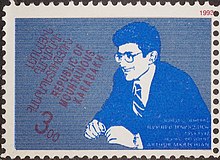Artur Mkrtchyan
This article relies largely or entirely on a single source. (November 2020) |
Artur Mkrtchyan Արթուր Մկրտչյան | |
|---|---|
 Mkrtchyan on a 1993 stamp of Nagorno-Karabakh | |
| Chairman of the Supreme Council of the Nagorno-Karabakh Republic | |
| In office 8 January 1992 – 14 April 1992 | |
| Prime Minister | Oleg Yesayan |
| Preceded by | Office established |
| Succeeded by | Georgi Petrosian (acting) |
| Personal details | |
| Born | 16 February 1959 Ukhtadzor, Nagorno-Karabakh Autonomous Oblast, Soviet Union |
| Died | 14 April 1992 (aged 33) Stepanakert, Nagorno-Karabakh Republic |
| Political party | ARF |
| Alma mater | Yerevan State University |
Artur Aslani Mkrtchyan (Armenian: Արթուր Ասլանի Մկրտչյան; 16 February 1959 – 14 April 1992) was the first Chairman of the Supreme Council of the Nagorno-Karabakh Republic, elected on 7 January 1992.[1] He made an important contribution to reinforcing the defensive capabilities of the Nagorno-Karabakh Republic, but was fatally shot under unclear circumstances in April 1992.
Biography
Artur Mkrtchyan was born in 1959 in the village of Ukhtadzor in the Hadrut District of the Nagorno-Karabakh Autonomous Oblast.[2] After graduating from the village secondary school in 1976, he entered the faculty of history at Yerevan State University.[2] After graduating from university, he conducted his post-graduate studies at the Institute of Anthropology and Ethnography in Moscow.[2] From 1981 to 1983 he worked at the Armenia Ethnography Museum.[2] In 1986 he returned to his hometown to work as the director of the Hadrut Historical-Geological Museum.[2] In 1988 he defended his PhD thesis and received the degree of Candidate of Historical Sciences.[2]
Mkrtchyan was an active participant in the Karabakh movement from its early days.[2] He joined the Armenian Revolutionary Federation (ARF) and after that party's victory in the 1991 Nagorno-Karabakh parliamentary election, he was elected the first Chairman of the Supreme Council of the Nagorno-Karabakh Republic on 7 January 1992.[2]
Mkrtchyan was killed in his apartment in Stepanakert under mysterious circumstances on 14 April 1992.[3] While an initial report by the NKR's interior minister, Armen Isagulov, stated that Mkrtchyan had been killed by unknown "gunmen," a later official report described his death as accidental.[4][5] In 2019, former commander of the NKR's army, Samvel Babayan, claimed that Mkrtchyan's death was a suicide․[6] No one has ever been prosecuted in connection with his death.[7] He was succeeded by Georgy Petrosyan as acting chairman of the Supreme Council.[4]
Mkrtchyan had two children. In 2020, Mkrtchyan was posthumously awarded the title of Hero of Artsakh.[7]
References
- ^ "Nagorno-Karabagh". University of Michigan-Dearborn. 2013. Archived from the original on 20 June 2010. Retrieved 20 October 2013.
On January 8, 1992, Artur Mkrtchian was elected President and Oleg Yessaian as Prime Minister of Karabagh by Karabagh's Parliament. Note that this Presidency is not an independent office such as in the United States.
- ^ a b c d e f g h "Artur A. Mkrtchyan". www.nankr.am. Archived from the original on 27 December 2018. Retrieved 24 August 2021.
- ^ Hakobyan, Tatul (26 August 2020). "Արթուր Մկրտչյան. In Memoriam". ANI Armenian Research Center. Archived from the original on 24 August 2021. Retrieved 24 August 2021.
- ^ a b "Death of Leader in Karabakh Is Called Accidental". Los Angeles Times. 16 April 1992. Archived from the original on 2 May 2022. Retrieved 2 May 2022.
- ^ "Armenian Leader of Nagorno-Karabakh Parliament Assassinated". Los Angeles Times. 15 April 1992. Archived from the original on 2 May 2022. Retrieved 2 May 2022.
- ^ Minasyan, Lusine (19 April 2019). "Ասել եմ` վերջ տվեք, եթե չեք ուզում այդ մարդուն վարկաբեկել. Սամվել Բաբայանը` դաշնակցական Արթուր Մկրտչյանի մահվան մասին" ['I said: stop, if you do not want to ruin that man's reputation'. Samvel Babayan on ARF member Artur Mkrtchan's death]. armlur.am. Archived from the original on 2 May 2022. Retrieved 2 May 2022.
- ^ a b "Artur Mkrtchyan to be Posthumously Awarded Title of "Artsakh Hero"". Hetq.am. 26 August 2020. Archived from the original on 1 May 2022. Retrieved 2 May 2022.
{{cite web}}:|archive-date=/|archive-url=timestamp mismatch; 2 May 2022 suggested (help)
